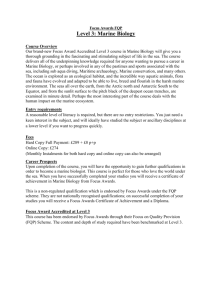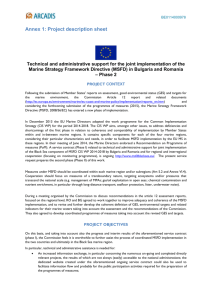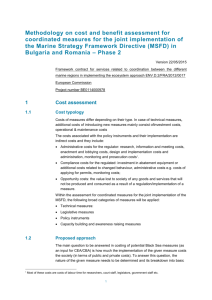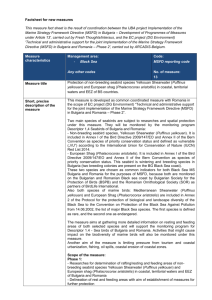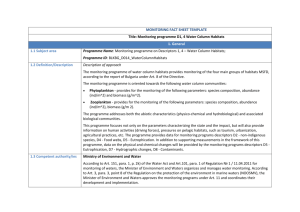Factsheet_combined DE and BE_final 26052015
advertisement
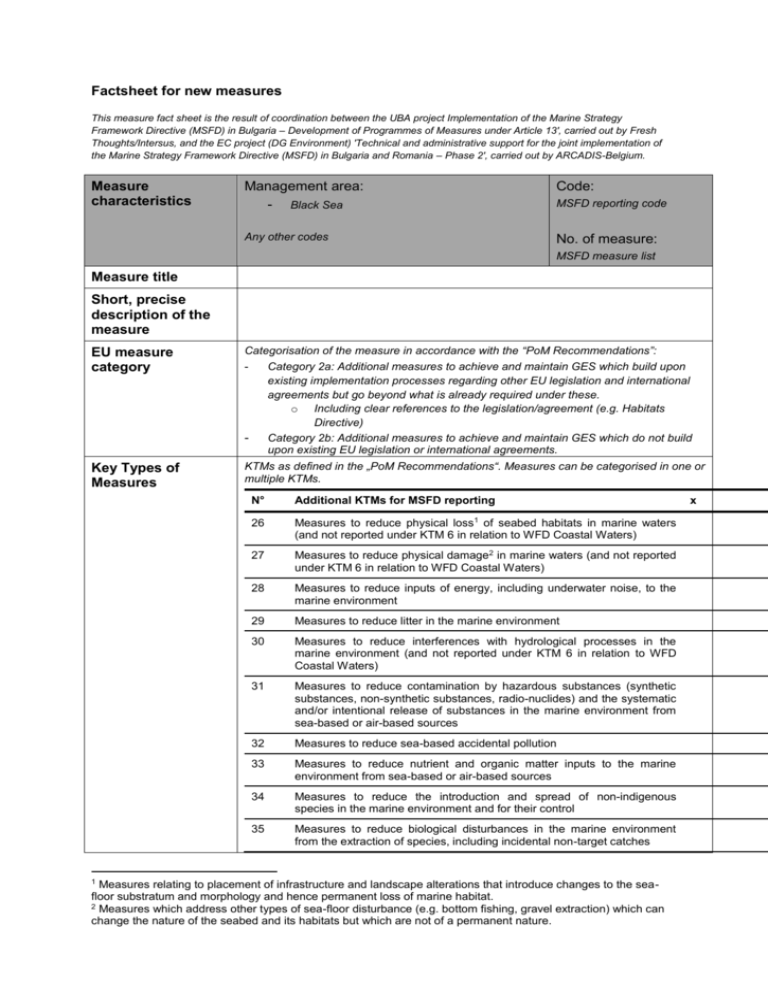
Factsheet for new measures This measure fact sheet is the result of coordination between the UBA project Implementation of the Marine Strategy Framework Directive (MSFD) in Bulgaria – Development of Programmes of Measures under Article 13', carried out by Fresh Thoughts/Intersus, and the EC project (DG Environment) 'Technical and administrative support for the joint implementation of the Marine Strategy Framework Directive (MSFD) in Bulgaria and Romania – Phase 2', carried out by ARCADIS-Belgium. Measure characteristics Management area: - Black Sea Code: Any other codes No. of measure: MSFD reporting code MSFD measure list Measure title Short, precise description of the measure EU measure category Categorisation of the measure in accordance with the “PoM Recommendations”: Category 2a: Additional measures to achieve and maintain GES which build upon existing implementation processes regarding other EU legislation and international agreements but go beyond what is already required under these. o Including clear references to the legislation/agreement (e.g. Habitats Directive) - Category 2b: Additional measures to achieve and maintain GES which do not build upon existing EU legislation or international agreements. Key Types of Measures KTMs as defined in the „PoM Recommendations“. Measures can be categorised in one or multiple KTMs. 1 N° Additional KTMs for MSFD reporting 26 Measures to reduce physical loss1 of seabed habitats in marine waters (and not reported under KTM 6 in relation to WFD Coastal Waters) 27 Measures to reduce physical damage2 in marine waters (and not reported under KTM 6 in relation to WFD Coastal Waters) 28 Measures to reduce inputs of energy, including underwater noise, to the marine environment 29 Measures to reduce litter in the marine environment 30 Measures to reduce interferences with hydrological processes in the marine environment (and not reported under KTM 6 in relation to WFD Coastal Waters) 31 Measures to reduce contamination by hazardous substances (synthetic substances, non-synthetic substances, radio-nuclides) and the systematic and/or intentional release of substances in the marine environment from sea-based or air-based sources 32 Measures to reduce sea-based accidental pollution 33 Measures to reduce nutrient and organic matter inputs to the marine environment from sea-based or air-based sources 34 Measures to reduce the introduction and spread of non-indigenous species in the marine environment and for their control 35 Measures to reduce biological disturbances in the marine environment from the extraction of species, including incidental non-target catches Measures relating to placement of infrastructure and landscape alterations that introduce changes to the seafloor substratum and morphology and hence permanent loss of marine habitat. 2 Measures which address other types of sea-floor disturbance (e.g. bottom fishing, gravel extraction) which can change the nature of the seabed and its habitats but which are not of a permanent nature. x 36 Measures to reduce other types of biological disturbance, including death, injury, disturbance, translocation of native marine species, the introduction of microbial pathogens and the introduction of genetically-modified individuals of marine species (e.g. from aquaculture) 37 Measures to restore and conserve marine ecosystems, including habitats and species 38 Measures related to Spatial Protection Measures for the marine environment (not reported under another KTM) 39 Other measures Environmental targets Categorisation of the measures in accordance with the nationally defined operational environmental objectives. Descriptors Categorisation of the measures to the descriptors in lined with Annex 1 MSFD. The descriptors are identified by their short form: D1- Biodiversity D2 – Non-native species D3 – State of commercial fish and shellfish stocks D4 – Food web D5 – Eutrophication D6 – Seabed D7 – Hydrographic conditions D8 – Pollutants D9 – Contaminants in food D10 – Marine litter D11 – Energy lines Main pressures Using the analysis carried out in 2012 as a basis, categorisation of the measures in accordance with the pressures defined in Annex 3 MSFD, Table 2: Physical loss Physical damage Other physical disturbance Interference with hydrological processes Contamination from hazardous substances Systematic and/or international release of substances Nutrient and organic matter enrichment Biological disturbances. Main drivers The sectors/activities targeted by the measure Characteristics Using the analysis carried out in 2012 as a basis, categorisation of the measures in accordance with the characteristics defined in the “PoM Recommendations”: Marine and coastal birds Marine mammals Reptiles Fish Cephalopods Benthic habitats Pelagic habitats Link to other directive/legislation/ policy Aligning objectives with other legal commitments Necessity for transnational regulation Information as regarding the necessity for regulations at EU, regional and international level to achieve MSFD environmental objectives. Instrument for implementation/ Mode of action Stating the implementation process in line with the „PoM Recommendations“; multiple options possible: Legal Technical Political Economic Potentially also stating additional concrete instruments useful for implementation Spatial reference Contribution of the measure to achieving the target i.e. the spatial impact of the measure: whole Black Sea, regional, local – using technical information Transboundary impact Information on the impact of the measures on transboundary neighbours Costs costs for the implementation Effectiveness Effectiveness of the measure in reaching targets (either qualitative description, or according to indicators: indicators for environmental targets and for GES, proposal for statistical indicators in support of Art. 18 interim reports Socio-economic assessment - Coordination Selection of the governance level that will coordination the implementation of the measures, i.e. local, national Regional, bilateral Options: Frequently applied, Best Available Technologies (BAT) Frequently applied; extensive experience / evidence of good practice Applied; limited experience / uncertainties New development Technical feasibility Result CEA Result CBA Body responsible for the measure implementation Financing opportunities Including EU-cofinancing Planning of implementation 2016? Later? Exceptions (Article 14)? Difficulties in implementation Provide information on the potential challenges that could likely faced in implementation. Supporting information for SEA Additional values for protection (outside MSFD) Results from the SEA process e.g. climate, air, soil terrestrial ecosystems, monument protection Reasonable alternatives Description of identified alternatives including the baseline





